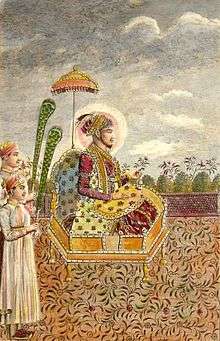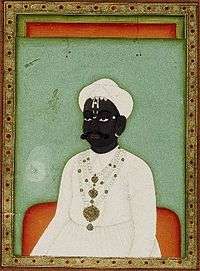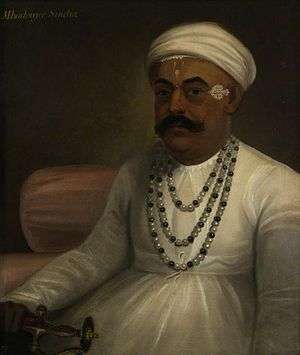Mahadaji Shinde
| Mahadji Shinde | |||||
|---|---|---|---|---|---|
| Maharaja (Ruler of Gwalior), Vakil-ul-Mutlaq (Regent of the Empire), Amir-ul-Umara(Head of the amirs)[1] | |||||
|
Mahadaji Shinde by James Wales | |||||
| Reign | 18 January 1768 — 12 February 1794 | ||||
| Coronation | 18 January 1768 | ||||
| Predecessor | Manaji Rao Shinde | ||||
| Successor | Daulat Rao Shinde | ||||
| Born | 3 December 1730 | ||||
| Died |
12 February 1794 Wanawadi near Pune | ||||
| Spouse | 4 wives | ||||
| Issue |
Daulat Rao Shinde (adopted son) Bala Bai Chimna Bai | ||||
| |||||
| House | Shinde | ||||
| Father | Ranoji Rao Shinde | ||||
| Mother | Chima Bai | ||||
| Religion | Hinduism | ||||
Mahadaji Shinde ( Marathi: महादजी शिंदे Mahādajī Śiṃdē ) ( 3 December 1730 – 12 February 1794) also spelled as Mahadji Scindia, was a Maratha ruler of the Maratha Empire of the state of Gwalior in central India. He was the fifth and the youngest son of Sardar Ranoji Rao Scindia.
Mahadaji was instrumental in resurrecting Maratha power in North India after the Third Battle of Panipat in 1761, and rose to become a trusted lieutenant of the Peshwa, leader of the Maratha Empire. Along with Madhavrao I and Nana Fadnavis, he was one of the three pillars of Maratha Resurrection. During his reign, Gwalior became the leading state in the Maratha Empire and one of the foremost military powers in India. After accompanying Shah Alam II in 1771 to Delhi, he restored the Mughals in Delhi, under the suzerainty of Marathas.[2]
He annihilated the power of Jats of Mathura and during 1772-73 and destroyed the power of Pashtun Rohillas in Rohilkhand and captured Najibabad. His role during the First Anglo-Maratha War was greatest from the Maratha side since he humbled the British in Central India, single handed, which resulted in the Treaty of Salbai in 1782, where he mediated between the Peshwa and the British.
After the Treaty of Salbai in 1782, he invaded and overpowered the Rajput states, particularly Jodhpur and Jaipur through the Battle of Patan, the Battle of Medtya and the capturing of Ajmer in 1790. Even Sikh sardars of the cis-Sutlej region paid tributes to him.[3]
Mahadji became Vakil-ul-Mutlaq (regent of Mughal affairs), and The Mughals also gave him the title of Amir-ul-Umara (head of the amirs) in 1784.[4]
Later campaigns

When the Maratha army crossed the Narmada in February 1770, the Jat king Nawal Singh of Bharatpur opposed them. However, in the battle on 6 April 1770 Mahadji defeated him and Maratha supremacy over the North was evident.
In 1777-78, Mahadji provided military assistance to the Peshwas against the Maratha army of Kolhapur. Mahadji besieged and conquered the town of Karvir in Kolhapur.
First Anglo-Maratha War

In 1773, Peshwa Narayanrao was murdered in a conspiracy involving his uncle Raghunathrao who placed himself as the next Peshwa although he was not a legal heir. Meanwhile, a group of twelve Maratha chiefs known as the Barbhai council made Narayanrao's infant son Sawai Madhavrao the legal Peshwa. The Barbhai council included Mahadji Scindia and Nana Phadnis, who was acted as the Peshwa's regent. Raghunathrao, unwilling to give up his position of power, sought help from the British East India Company at Bombay.
Battle of Wadgaon, 1779
In 1777, Nana Phadnis violated his treaty with the Calcutta Council by granting the French a port on the west coast. The British replied by sending a force towards Pune. On 16 January, the British signed the Treaty of Wadgaon that forced the Bombay government to relinquish all territories acquired by East India Company in western India since 1773 which included Sashti (Salsette), Thane, and the entire Gujarat region. The British were also made to pay Rs. 41,000 as an indemnity to the army of Mahadji. It was agreed that Raghunathrao would be handed to the Marathas. On 18 January 1779 Mahadji captured Raghunathrao and his forces. He also defeated and arrested Sakharam Bapu and imprisoned him in the jail of Sinhagad.
British defeat in Central India

The British Governor-General in Bengal, Warren Hastings, rejected the Treaty of Wadgaon on the grounds that the Bombay officials had no legal power to sign it, and ordered Colonel Goddard to secure British interests in the area. Goddard's 6,000 troops captured Ahmedabad in February 1779, and Bassein in December 1780. Skirmishes took place between Mahadji Scindia and General Goddard in Gujarat, but indecisively.
Another Bengal detachment led by Captain Popham captured Gwalior Fort on 4 August 1780, before Mahadji Scindia could make preparations. Hastings sent yet another force commanded by Major Camac to harass Mahadji Scindia. In February 1781, the British beat Mahadji at the town of Sipri, but every move they made after that was shadowed by his larger army, and their supplies were cut off, until they made a desperate night raid on 24 March, capturing not only supplies, but even guns and elephants. Thereafter, the military threat from Scindia's forces to the British was much reduced.
Colonel Murre arrived with fresh forces in April, 1781, to assist Popham and Camac. After his defeat at Sipri, Mahadji Scindia got alarmed. Finally, he decisively crushed the forces of Murre on 1 July 1781.
Learning about these defeats, Warren Hastings, who arrived at Varanasi, urged Colonel Murre to begin peace talks with Mahadji.[5]
Treaty of Salbai 17 May 1782
After the British defeat, Hastings through Murre proposed a new treaty, known as the Treaty of Salbai, between the Peshwa and the British that would recognize Sawai Madhavrao as the Peshwa and grant Raghunath Rao a pension. The treaty also returned to Shinde all his territories west of the Yamuna and so was made to withdraw to Ujjain. A resident, Mr. David Anderson (1750-1825), of St. Germains [6] (who had negotiated the treaty) was at the same time appointed to Mahadji's court.
Later Years
Another achievement of Mahadji was his victory over the Nizam of Hyderabad’s army in a battle. The Nizam state ceased be a factor in the north Indian politics after this battle and it generally confined itself in the Deccan afterwards. After the peace made with Tipu Sultan of Mysore in 1792, Mahadji exerted his influence to prevent the completion of a treaty between the British, the Nizam of Hyderabad, and the Peshwa, directed against Tipu.
Death and legacy

.
After the Battle of Lakheri, Mahadji was now at the zenith of his power, when he died, at his camp at Wanavdi near Pune on 12 February 1794. He left no heir, and was succeeded by Daulat Rao Scindia, a grandson of his brother Tukoji Rao Scindia, who was scarcely 15 years of age at the time.
Kini, the English biographer of Mahadaji Shinde, has described Mahadaji as the greatest man in South Asia in the 18th century.[7] Mahadaji Shinde’s role was instrumental in establishing Maratha supremacy over North India.
Shinde Chhatri, located in Wanowrie, in Pune is a memorial dedicated to Mahadji Shinde. It is a hall that marks the spot of Mahadji Shinde's cremation on 12 February 1794. The three storied memorial in Rajput architectural style, is one of the most significant landmarks in the city.
After the Maratha defeat at Panipat, Mahadaji is said to have offered his pagri (turban) to the deity at the Kal Bhairav temple in Ujjain, praying for victory in his campaign to restore the Maratha rule in North India. After successfully resurrecting Maratha power, he carried out restoration of the temple. Since then, the temple deity's head has been adorned with a pagri. [8]
See also
References
- ↑ https://books.google.com/books?id=sxhAtCflwOMC&pg=PA334
- ↑ The Great Maratha Mahadaji Shinde - N. G. Rathod - Google Books. Books.google.co.in. Retrieved 2012-07-21.
- ↑ History Of The Marathas - R.S. Chaurasia - Google Books. Books.google.co.in. Retrieved 2012-05-26.
- ↑ A Comprehensive History of Medieval India: From Twelfth to the Mid ... - Farooqui Salma Ahmed, Salma Ahmed Farooqui - Google Books. Books.google.co.in. Retrieved 2012-07-21.
- ↑ The Great Maratha.NG Rathod.p.20
- ↑ Burkes Landed Gentry: Anderson of Northfield
- ↑ https://books.google.com/books?id=uPq640stHJ0C&pg=PA156&lpg=PA156&dq=mahadji+shinde+titles&source=bl&ots=Ohyu5mwQmk&sig=vWWtlHI6zQ9eX8866sRgyIxtJcw&hl=en&sa=X&ei=3h9DUL6UHc2qrAf7ioHYCA&redir_esc=y#v=onepage&q=mahadji%20shinde%20titles&f=false
- ↑ "ग्रहों की बाधाएं दूर करते है उज्जैन के कालभैरव" (in Hindi). Aaj Tak. 17 January 2015.
- Hunter, William Wilson, Sir, et al. (1908). Imperial Gazetteer of India, Volume 12. 1908–1931; Clarendon Press, Oxford.
- Keene, H. G. The Fall of the Moghul Empire of Hindustan e-text
- Markovits, Claude (ed.) (2004). A History of Modern India: 1480–1950. Anthem Press, London.
External links
| Wikimedia Commons has media related to Mahadaji Scindia. |
| Mahadaji Shinde Born: 3 December 1730 Died: 12 February 1794 | ||
| Regnal titles | ||
|---|---|---|
| Preceded by Manaji Rao Scindia |
Maharaja of Gwalior 1768–1794 |
Succeeded by Daulat Rao Scindia |
